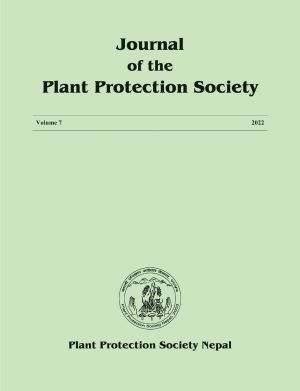Biology and Bioassay of Spotted Beetle in Bitter gourd in Chitwan, Nepal
DOI:
https://doi.org/10.3126/jpps.v7i01.47285Keywords:
Epilachna dodecastigma, oviposition, spotted beetleAbstract
Biological study of Epilachna dodecastigma revealed that a female laid average of 283.25 ± 25.88 eggs in different clusters; each cluster contained 25-65 eggs on the surface of the leaves and the ovi-position period was 10.13 ± 3.33 days. The eggs of E. dodecastigma were bright yellow, elongate, oval and usually lay on the undersurface of the leaves with size of 54.8 ± 0.37μm length and 15.26 ± 0.6 μm in breadth. The larva of E. dodecastigma was yellow in color, elongate and elliptical in shape with moderately long legs and a well-developed head and mandibles. The length and breadth of first, second, third and four instars were 1.41 ± 0.24 mm and 0.56 ± 0.06 mm; 4.2 ± 0.2 mm and 1.9 ± 0.1 mm; 6.2 ± 0.2 mm and 3.2 ± 0.2 mm and 7.8 ± 0.2 mm and 3.4 ± 0.24 mm, respectively. Total duration of larvae was 11.54 ± 0.43 days. The average length and breadth of pupae was measured 7 ± 0.3 mm and 5.4 ± 0.24 mm in the field condition with pupal duration of 5.50 ± 0.24 days. The average length and breadth of the male adult measured 7.2 ± 0.24 mm and 5.8±0.2 mm and average length and breadth of female adult 7.6±0.24 mm and 6 ± 0.0 mm respectively in the field condition. The results of the bioassay experiments showed the highest larval mortality with chloropyriphos & cypermethrin followed by spinosad, derisom, margosom, B. bassiana and water spray (control).
Downloads
Downloads
Published
How to Cite
Issue
Section
License

This work is licensed under a Creative Commons Attribution-NonCommercial 4.0 International License.
© Plant Protection Society of Nepal

